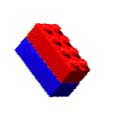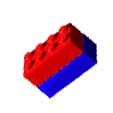
by Linda Jacobson


by Linda Jacobson


More information about the LEGO Group can be found at
For more information about the computer systems used in VR production:
For more information about the software used in VR production:
Virtual Research Systems: Head Mounted Display
|
We humans are social creatures. We enjoy doing things together. Fact is, we're
interdependent. Perhaps our need for each other is the reason the Internet allures us:
it transforms our computers into community centers. The Web brings color,
movement, and non-linearity to the community, while VRML adds a sense of space.
VRML-enhanced Web sites hint at how citizens soon may interact with each other inside virtual space via desktop computer. But right now, behind the scenes, folks are working in collaborative, immersive, simulation-based environments. Such an environment exists inside the Virtual Reality lab at the LEGO Group, makers of the world's most popular toys. Home of Scandanavia's largest computer graphics studio, the LEGO Group has engaged in CAD engineering for many years. Today the company uses a 3D graphics database of toy kit elements for asset management and to develop for cartoons, movies and future toys, and other intriguing projects. Visionary artist Dent-de-Lion ("Dandi") du Midi is the LEGO Group's director of R&D. His team uses the database with Multigen's immersive 3D scene assembly package, SmartScene, to create LEGO Virtual Village, a networked collaborative play space. Dandi explains, "We're using a two-handed immersive interface because it's a better way to play with the data we work with." Instead of using networked VR to link people separated by distance, the Village enables two designers in one lab, each wearing VR goggles, to "play" together in virtual space. Here's how. The designers enter LEGO Village after putting on their Virtual Research or n-Vision headmount displays and Fakespace Pinch gloves, equipped with Polhemus or Ascension trackers. Inside, the designers access a virtual palette that provides hundreds of photorealistic LEGO parts and textures. With a fingertap, a designer picks any part; it appears in mid-air, ready to grab by hand for building. The designers can grab "the fabric of space," as Multigen dubs it, to navigate through the scene, shrink to LEGOman size, or swell to giant size to look over LEGOdom. After the scene is complete, the system generates a parts list. The designer can collect the appropriate plastic parts for assembling the plastic LEGO scene from that created in the Virtual Village. If it looks great in physical reality, it could be ready for the toy store. This approach to digital prototyping is supported by Onyx InfiniteReality. The supercomputer provides the juice necessary for real-time, collaborative interaction, and real-time interactivity is requisite for a CG-based development tool for LEGO Group engineers. It's in real time, after all, that kids play. Besides InfiniteReality's speedy graphics, fast system throughput, distributed simulation tools, and networking facilities, right out of the box it supports stereo VR displays and 3D controllers. The Performer and OpenGL APIs provide the foundation for Multigen to harness the hardware's power, achieving hardware-based texture mapping, multi-sample antialiasing to prevent dreaded "jaggies," and dynamic resolution to ensure steady frame rates, so vital for the sense of realism. The system updates the display at a rate of 15 frames per second, drawn twice to achieve stereo. The Virtual Village is built from 120,000 photoreal polygons (20,000 of which are interactive and/or animated); 30,000 polygons appear in view at a time. All 64MB of texture memory are used to create a richly rendered scene. As a result, designers can make fast creative decisions intuitively and in real time. Like kids play. Adults, like children, benefit from play with others. "We put our engineers in a shared space where they can learn from each other better," Dandi tells me. "If we play in a shared space, we can do all the things with virtual LEGO blocks that a kid can do playing with a friend. Next, we want to put multiple groups in a virtual world that stays perfectly synchronized, like military-type DIS. This way someone in our design lab can work with someone in package design, so we can support non-sequential design production. If people in shared spaces can hand their work instantaneously to another person, that's nice! With collaborative VR, we lose boundaries between people and machine, between people and people, and between machine and machine." If you're considering breaking those boundaries, keep this in mind: collaborative VR works on any Onyx or Onyx2, and on Indigo2 Maximum IMPACT workstations, and is best when the machines at each end of the connection provide the same performance specs. As the demand for virtual environments grows, you will achieve visual complexity at unprecedented performance levels. Please send us your feedback on this article. Previous cover stories featured on Silicon Surf can be found in the Archives
|
![[Silicon Surf]](surf.gif)